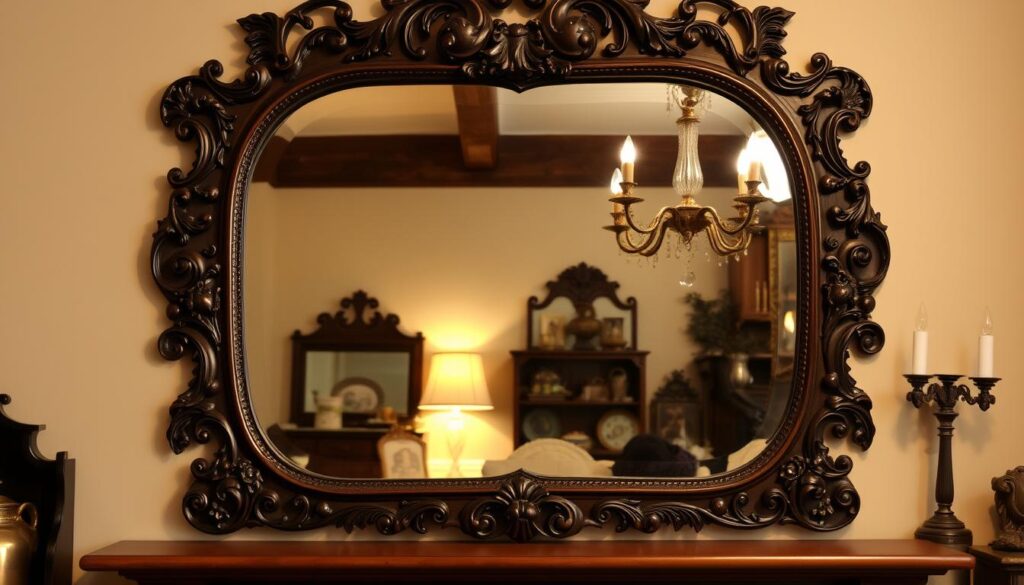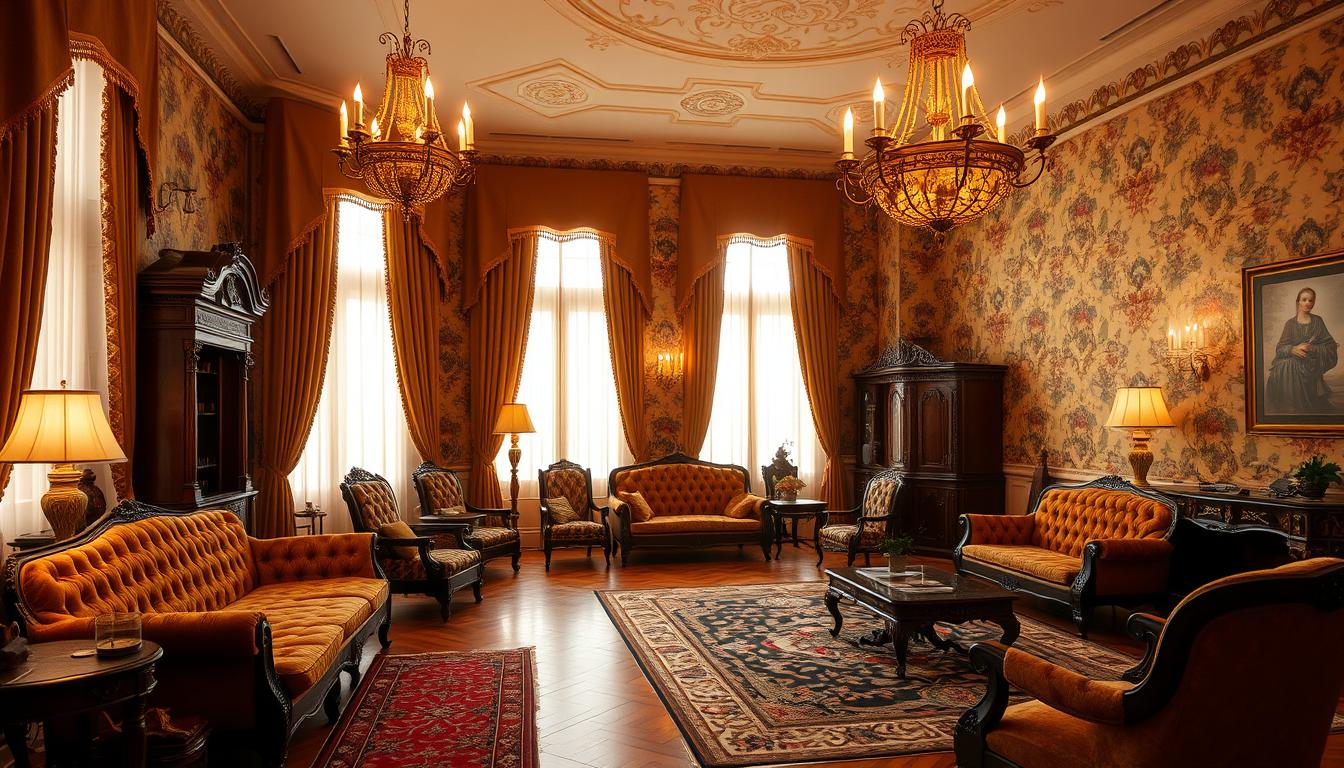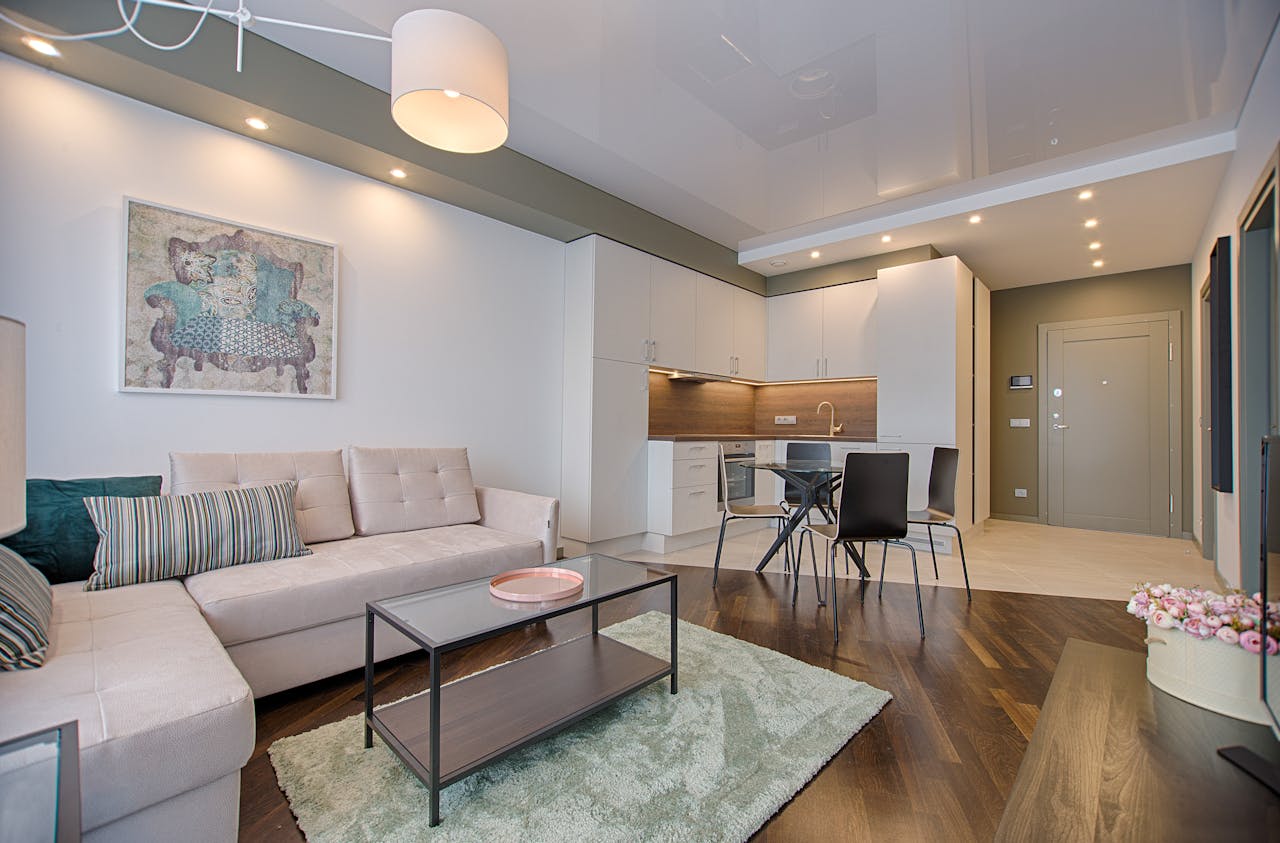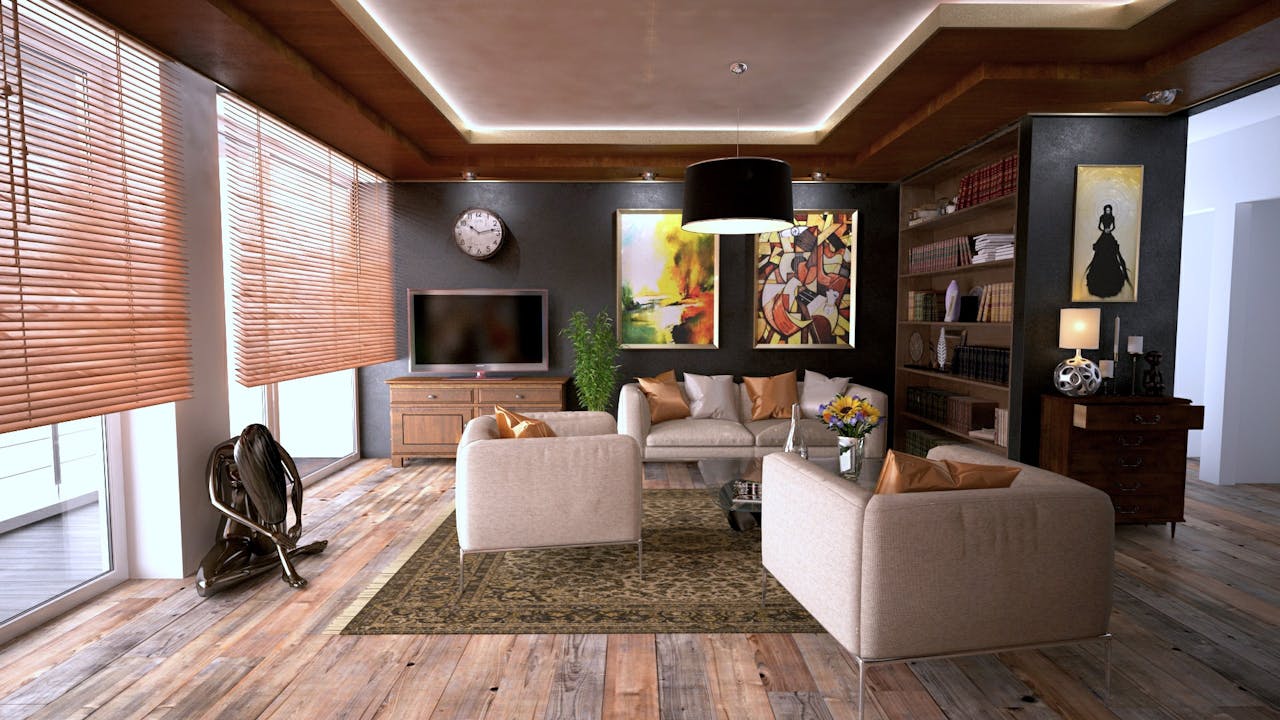Did you know Victorian decor has been a favorite for home interiors for over a century? Its lasting charm comes from its opulence and grandeur. With intricate patterns, rich colors, and ornate details, Victorian style can turn any home into a luxurious haven.
To bring this elegant style into your home, think about grand, intricately carved fireplaces. Also, plush velvet upholstered furniture and rich, damask wallpaper are key. These elements will create a sophisticated and refined atmosphere. It’s perfect for those who love the classic beauty of Victorian decor.
Key Takeaways
- Incorporate grand fireplaces and plush furniture for a luxurious feel.
- Use rich, damask wallpaper to add depth and elegance.
- Mix patterns and textures to achieve a true Victorian spirit.
- Choose rich and dark tones for a characteristic Victorian color scheme.
- Commanding light fixtures are essential for a Victorian-style space.
Understanding Victorian Home Interior Aesthetics
Exploring Victorian home interiors takes us back to a time of luxury and grandeur. The Victorian era was all about opulence, leaving a mark on interior design. With its intricate details and rich colors, Victorian interiors showcase the skill of the time.
Key Characteristics of Victorian Style
Victorian interiors stand out with their detailed molding, ceiling medallions, and grand chandeliers. These features create a lavish atmosphere typical of Victorian homes. The intricate woodwork and ornate furnishings add to the luxurious vibe.
The Victorian style is also known for its rich textures and patterns. From patterned wallpaper to plush furnishings, every detail invites coziness and warmth. The use of velvet and silk adds depth and visual appeal.
The Importance of Color Schemes
Color schemes are key in Victorian interior design. Deep colors like burgundy, emerald green, and royal blue create a dramatic, luxurious feel. These colors are often paired with neutral tones to balance the space and avoid overwhelming it.
The right color scheme can greatly enhance a Victorian home’s look. Choosing colors that match the era’s features creates a cohesive, harmonious interior. Colors can also highlight specific design elements, like intricate molding or ornate furnishings.
| Color | Usage | Effect |
|---|---|---|
| Burgundy | Accent walls, furnishings | Creates a warm, luxurious atmosphere |
| Emerald Green | Accent pieces, wallpaper | Adds a touch of elegance and sophistication |
| Royal Blue | Furnishings, drapery | Contributes to a dramatic, opulent feel |
Key Elements of Victorian Decor
Victorian decor is known for its elegance and sophistication. The Victorian era loved detail and opulence. This is seen in the decorative elements of that time.
Intricate Woodwork and Moldings
Intricate woodwork and moldings are key in Victorian architecture and furniture. Elaborate carvings and turned legs add sophistication. You can add wooden paneling or crown moldings to your home.
Rich, dark woods like mahogany and walnut were common. They add warmth and depth. Using these elements can make your home look authentic Victorian.
Window Treatments and Drapery
Victorians loved opulent window treatments. Silk draperies and heavy velvet curtains were favorites. They were often decorated with tassels and other ornaments.
To get a similar look, use heavy fabrics and layer your treatments. You can mix curtains with blinds or add valances and pelmets. The goal is to create grandeur and drama.
Choosing the Right Color Palette
Creating a Victorian-inspired color palette is more than picking colors. It’s about capturing the era’s essence. The right colors can take you back to a time of elegance and sophistication. We’ll explore Victorian colors and guide you on choosing a palette that fits your home’s unique character.
Popular Victorian Color Combinations
Victorian interiors are famous for their rich, bold colors. Some popular combinations include:
- Rich jewel tones such as emerald green and sapphire blue
- Deep, muted shades like burgundy and moss
- Warm neutrals such as terracotta and golden brown
These colors were often used in intricate patterns and designs. They add depth and visual interest to rooms.
Tips for Mixing and Matching Colors
Mixing Victorian-era colors needs careful thought. Here are some tips for a harmonious palette:
- Start with a Neutral Base: Begin with a neutral base color. Then, add richer, bolder colors through furniture and decor.
- Consider the 60-30-10 Rule: Use 60% of the room for a dominant color, 30% for a secondary color, and 10% for an accent color.
- Balance Warm and Cool Tones: Make sure your palette balances warm and cool tones. This prevents the space from feeling too cold or too warm.
To see how these colors work together, look at the image below. It shows a typical Victorian color palette in action.
By understanding Victorian color schemes and applying simple principles, you can create a beautiful Victorian-inspired color palette for your home.
Furniture Selection for a Victorian Home
Choosing the right furniture is key to capturing the Victorian home’s essence. The Victorian era is famous for its richly decorated interiors. Furniture is a big part of this look.
When picking furniture for a Victorian home, look for pieces that show off the era’s unique style. Tufted furniture and wingback chairs are must-haves. They bring elegance and sophistication to any room.
Types of Furniture to Consider
Victorian furniture is known for its detailed designs and ornate looks. Some essential pieces include:
- Ornate sofas with carved wooden frames
- Tufted armchairs with velvet upholstery
- Wingback chairs with intricate patterns
- Mahogany and walnut wooden furniture
These items not only show off the Victorian style but also elevate your home’s look.
Reupholstering Vintage Pieces
Reupholstering old furniture is a smart way to add Victorian flair to your home. It keeps the furniture’s original craftsmanship while giving it a fresh look.
For reupholstery, use fabrics popular in the Victorian era, like velvet, silk, and heavy brocades. These fabrics match the Victorian style and add texture and depth to your furniture.
| Furniture Piece | Original Fabric | Reupholstered Fabric |
|---|---|---|
| Tufted Armchair | Worn Velvet | Rich Brocade |
| Wingback Chair | Faded Silk | Luxurious Velvet |
By choosing and reupholstering vintage pieces, you can create a Victorian-inspired interior. It will be both elegant and unique.
“The art of furnishing is not just about filling a space, it’s about creating an atmosphere that reflects your personal style.”
Incorporating Textiles and Patterns
Rich textiles and intricate patterns are essential for Victorian design. The Victorian era loved opulence and grandeur. Luxurious fabrics were key to achieving this look in home interiors.
Fabrics That Define the Victorian Era
The Victorian era used heavy fabrics like velvet, silk, and brocade. These fabrics had detailed patterns, including florals and stripes. Velvet upholstery and silk draperies were favorites, adding luxury to homes.
- Velvet
- Silk
- Brocade
- Damask
Layering Textiles for Depth
Layering different textiles and patterns is vital for a rich look in Victorian interiors. Mixing fabrics, textures, and patterns adds depth and interest. For example, a velvet sofa with silk throw pillows and a brocade blanket makes a room cozy.
- Start with a base layer of heavy drapery or upholstery.
- Add throw pillows and blankets in complementary patterns and textures.
- Use rugs and mats to add additional layers of texture and warmth.
By using various textiles and patterns, we can create a Victorian-inspired space. This space reflects the era’s love of luxury and grandeur.
Lighting to Complement Victorian Interiors
In Victorian homes, lighting is more than just a need. It’s a way to make a room feel luxurious and welcoming. The right lighting can make a room look more elegant and inviting.

Victorian decor loves grand and ornate lighting. Crystal chandeliers and candelabras are key, bringing glamour and sophistication to any space.
Types of Lighting Fixtures
Victorian homes have many lighting fixtures, each with its own role. Some common ones are:
- Candelabras and candlesticks, which give a warm, soft light.
- Crystal chandeliers, central to Victorian style, adding elegance.
- Sconces, used to light up architectural features and create pools of light.
These fixtures do more than just light up a room. They also decorate, enhancing the Victorian style of the home.
Using Candles and Chandeliers
Candles and chandeliers are essential in Victorian lighting. Candles were a main light source back then, adding warmth and ambiance.
“The soft, flickering light of candles creates a cozy and intimate atmosphere, perfect for a Victorian-style living room.”
Chandeliers, on the other hand, are eye-catching. Choose one with detailed designs and crystals to enhance the Victorian look.
By picking the right lighting fixtures and placing them well, homeowners can bring the Victorian era to life. It’s a way to capture the era’s style and elegance in their homes.
Wall Treatments and Artwork
To get a true Victorian vibe, focus on wall treatments and artwork. The Victorian era loved luxury and detail. This is seen in how they decorated their walls.
Rich Wallpaper Trends
Victorian wallpaper is known for its intricate patterns and rich colors. It often has floral motifs, damask patterns, and other intricate designs. These add depth and interest to any room.
For instance, modern Victorian style mixes old wallpaper trends with a fresh twist. It blends the classic with the contemporary.
Framing and Displaying Art
Victorian homes often feature masterful oil paintings and ornate frames. When displaying art, choose frames that match the artwork and room décor.
- Look for frames with detailed and ornate designs to fit the Victorian look.
- Use gilded frames for a luxurious touch.
- Arrange artwork to balance and harmonize on the wall.
Design experts say the right frame can make art stand out. By picking and arranging artwork carefully, you can create a stunning display. This reflects the Victorian era’s love for beauty and skill.
Creating Cozy Spaces with Accessories
Exploring Victorian decor, we see how accessories make spaces cozy and inviting. They add a personal touch, making rooms feel welcoming.
Decorative mirrors are key in Victorian homes. Gilded mirrors bring elegance and sophistication to any room.
Decorative Mirrors and Their Impact
Decorative mirrors do more than look good in Victorian homes. They make rooms seem bigger by reflecting light and images. Choose a mirror that fits the room’s style.
A gilded mirror adds luxury and refinement. Its ornate details enhance the room’s look, matching other ornate pieces.

Choosing the Right Rugs
Rugs are vital for cozy Victorian spaces. Oriental or Persian rugs add warmth and character. They bring history and tradition to a room.
When picking a rug, think about color and pattern. It should match the decor and feel warm underfoot. A patterned rug can unite the room’s design elements.
With decorative mirrors and the right rugs, we can make Victorian spaces elegant and cozy.
Modern Touches in a Victorian Setting
Mixing modern elements with Victorian decor needs careful thought. When done right, it creates a unique and balanced look. This honors the past while welcoming the present.
Balancing Old and New
Adding modern pieces to a Victorian home is possible. You can mix modern and vintage furniture. For example, a sleek sofa and an antique armchair make a striking contrast.
Tips for a Harmonious Design
For a harmonious design, think about scale, texture, and color. In a Victorian renovation, keep the original style’s integrity. Then, add modern touches to improve the look.



